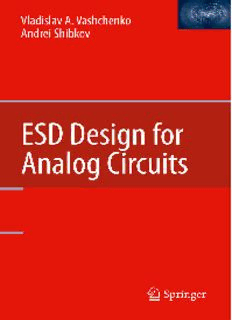
ESD Design for Analog Circuits PDF
Preview ESD Design for Analog Circuits
ESD Design for Analog Circuits · Vladislav A. Vashchenko Andrei Shibkov ESD Design for Analog Circuits 123 VladislavA.Vashchenko AndreiShibkov NationalSemiconductor AngstromDesignAutomation SemiconductorDriveM/SE-155 1336FruitdaleAve.A3 SantaClara,CA95052 SanJose,CA95126 USA USA [email protected] [email protected] ISBN978-1-4419-6564-6 e-ISBN978-1-4419-6565-3 DOI10.1007/978-1-4419-6565-3 SpringerNewYorkDordrechtHeidelbergLondon LibraryofCongressControlNumber:2010929991 ©SpringerScience+BusinessMedia,LLC2010 Allrightsreserved.Thisworkmaynotbetranslatedorcopiedinwholeorinpartwithoutthewritten permission of the publisher (Springer Science+Business Media, LLC, 233 Spring Street, New York, NY10013,USA),exceptforbriefexcerptsinconnectionwithreviewsorscholarlyanalysis.Usein connectionwithanyformofinformationstorageandretrieval,electronicadaptation,computersoftware, orbysimilarordissimilarmethodologynowknownorhereafterdevelopedisforbidden. Theuseinthispublicationoftradenames,trademarks,servicemarks,andsimilarterms,eveniftheyare notidentifiedassuch,isnottobetakenasanexpressionofopinionastowhetherornottheyaresubject toproprietaryrights. Printedonacid-freepaper SpringerispartofSpringerScience+BusinessMedia(www.springer.com) Toourfamilies Preface ThisBookandSimulationSoftwareBundleProject Dear Reader, this book project brings to you a unique study tool for ESD protection solutions used in analog-integrated circuit (IC) design. Quick-start learningiscombinedwithin-depthunderstandingforthewholespectrumofcross- disciplinary knowledge required to excel in the ESD field. The chapters cover technical material from elementary semiconductor structure and device levels up tocomplexanalogcircuitdesignexamplesandcasestudies. The book project provides two different options for learning the material. The printedmaterialcanbestudiedasanyregulartechnicaltextbook.Atthesametime, another option adds parallel exercise using the trial version of a complementary commercialsimulationtoolwithpreparedsimulationexamples. Combination of the textbook material with numerical simulation experience presents a unique opportunity to gain a level of expertise that is hard to achieve otherwise.Thebookisbundledwithsimplifiedtrialversionofcommercialmixed- mode simulation software from Angstrom Design Automation. The DECIMMTM (Device CircuitMixed-Mode) simulatortooland complementary tothebook sim- ulation examples can be downloaded from www.analogesd.com. The simulation examples prepared by the authors support the specific examples discussed across thebookchapters. Akeyideabehindthisprojectistoprovideanopportunitytonotonlystudythe book material but also gain a much deeper understanding of the subject by direct experiencethroughpracticalsimulationexamples. Eachsectionofthebookisaccompaniedbyasetofsimulationexamplesdirectly relatedtothemaintopicsaddressedinthesection. Theexamplesarenotjustsnapshotsofthesimulationresults.Insteadthereader hasanoptiontouserealsimulationsoftwaretool.Thisallowsthereaderapractical opportunity to understand the ESD simulation examples by interactively studying the simulation results and changing simulation parameters within the limits of the trialversion. At the same time, the simulator software does not require any advanced skills in the technology computer sided design (TCAD) area. The authors of this book vii viii Preface andDECIMMTM simulationtooldevelopersbelievethatinteractivefeaturesofthe newtoolwillallowanyelectricalengineerorcircuitdesignertorunthesimulations successfully. Althoughthefreeversionofthesimulationhassomelimitationscomparedtothe full version, functionality of the free version is more than sufficient for it to be an indispensabletoolinmasteringofthesubjectofthisbook. Nevertheless,thereaderswhodonotwanttotakeanadvantageofthesimulation orprefertopostponetheexperiencecanreadthetextbookasanyregulartechnical textbook. The body of the book is prepared absolutely independent from the simulation examples,whicharereferredtoonlyattheendofeachchapter. SubjectandPurposeofThisBook ESD design for analog circuits is a very diverse and cross-disciplinary field. It involves an understanding of semiconductor device physics in strong non-linear operationregimedeepknowledgeofmodernCMOS,BICMOS,andBCDprocess technologies, expertise in analog circuit design mixed with understanding of the product application conditions and specs, and even trends in marketing for analog integratedcomponents. Therefore,oneofthemajorchallengesacceptedbytheauthorsofthisbookcon- sistsinselectionofanappropriatedepthofmaterialthatwillprovidepracticalhelp insuccessfulESDdesignandcanstillbeaccessibleenoughtobeusedbyabroad audience.Thischallengerequiresbothanappropriatesimplificationtofitthemate- rial within the limits of a single textbook and a new methodology to present the material.Themethodologyisbasedoncombiningthephenomenologicalapproach andsimulationresults. The book is organized in a hierarchy from the semiconductor device level to theproductcircuitlevel.Intheory,eachchaptercanbestudiedindependently.The sevenchaptersofthebookaddressthefollowinghierarchicallevels: I. SemiconductorStructures II. IntegratedStandardandESDDevices III. ESDClampDesignPrinciples IV. ESDProtectionNetworkDesignPrinciples V. ProtectionofSignalPathAnalogIntegratedCircuits VI. ProtectionofPowerManagementAnalogIntegratedCircuits VII. SystemLevelandDiscreteComponentESD ThisbooktargetsallmajoraspectsofESDprotection:device,network,andcir- cuitdesignlevels,mainlyfocusingonmodernintegratedcomponents.Systemlevel anddiscretecomponent’sESDprotectionisaddressedtoointhelastchapter. Preface ix Thishierarchyisestablishedinordertoenablebothsequentialandindependent studyofthematerialdependingofspecificreaderexpertiseandpreference. The authors expect that ESD engineers as well as students would appreciate a systematic representation of the material in increasing level of complexity. This approach covers the major background knowledge required for understanding the material. Professionals already working in this field with engineering background exper- tise in device design may find it useful to skip the device chapters and proceed to the ESD network and analog circuit design material, while experts in circuit designmaybenefitfromthedevicephysicsmaterialthatcoversphysicalprinciples ofconductivitymodulationinsemiconductorstructures. Theauthorsbelievethatanoptiontointeractivelystudythesimulationexamples willgreatlybenefitallreaders. The overall purpose of this book is to help professionals in the field to deal with the Analog ESD Design issues in their everyday professional work, attack- ing problems at all hierarchical levels starting from the device ESD level up to animplementationofintegratedself-protectingsolutions.Thebookissupposedto “arm”readersnotonlywithimportantpracticalandtechnicalknowledge,butalso to add a complementary simulation experience that can be further developed with the light version of new industrial mixed mode simulation software DECIMMTM fromAngstromDesignAutomation. TheBookStructure ThebookisorganizedinincreasingcomplexityofthediscussedESDsubjects.This is not complexity in terms of understanding, since that will depend on the level of expertise – circuit or device design – with which an engineering professional is approaching this book. Thus, the level of complexity of the material across the chaptersforcircuitdesignerswillperhapsbeoppositetothelevelofcomplexityfor deviceengineers. TheChapter1tothebookbelowrepresentsashortreviewofbackgroundmate- rial relevant to the ESD field, describing the authors’ understanding of the field itself,ESDpulsespecificationandseveralothergeneralaspects.Atthesametime, theintroductionmainlyrefersthereaderstootherpreviouslypublishedbooksinthe field,inordertomaximizethespaceinthecurrentbookformaterialpertainingto thegoalabove.Aswell,theintroductionestablishesimportantdefinitionsnecessary forunderstandingthepresentedmaterial. Chapter 2 presents introductory material to the device design field. It provides a fundamental knowledge of conductivity modulation processes in the elementary semiconductorstructures:p-n,p-i-n,n-p-n,p-n-p,p-n-p-n.Thephysicalprocesses in these structures are described on a simplified phenomenological level that is easy to understand and further supported by rather simple independent simulation examples.
Description: